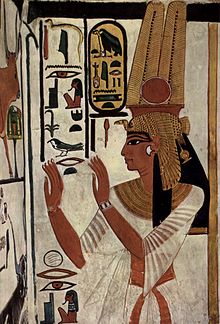Vulture hood

Vulture hood refers to an ancient Egyptian headdress in the form of a vulture's hide , which was probably made of gold plates over fabric .
history
The vulture hood was initially part of the iconography of the goddesses Nechbet and Mut . It was transferred from Nechbet to the lower Egyptian patron goddess Uto , in whom the vulture is often replaced by a snake's head. Nechbet and Uto already appear in human form in the Old Kingdom with a vulture hood and a three-piece strand or god wig.
The wig and vulture bonnet were incorporated into the iconography of the royal wives from the 4th dynasty and have been an integral part of them since the time of Pepi I ( 6th dynasty ). So z. B. Iput I , the wife of Teti II and mother of Pepi I, a vulture hood with a vulture's head, while the king's wife Neith (daughter of Pepi I and wife of Pepi II ) can be seen with a vulture hood and a uraeus snake .
In the Middle Kingdom , the royal wives almost exclusively wear snail wigs . The statuette of Sobeknofru from the 12th dynasty is a unique exception . This shows an unusual stranded wig, over which two vultures crouch with wings spread in a circle, between which a uraeus snake winds.
A combination of hathor wig and vulture hood has been worn since the New Kingdom . The position of the vulture hood is an important iconographic dating criterion . At the end of the 17th and the beginning of the 18th dynasty it sits on the apex of the head, while from the middle of the 18th dynasty it migrates to the back of the head. In connection with other crowns, the vulture hood now appears on the heads of various goddesses ( Meret ) and wives of God .
See also
literature
- Hans Bonnet : vulture hood. In: Lexicon of Egyptian Religious History. 3rd unchanged edition. Nikol, Hamburg 2000, ISBN 3-937872-08-6 , p. 211.
- Emma Brunner-Traut : Vulture hood. In: Wolfgang Helck (Ed.): Lexicon of Egyptology. Volume 2: Harvest Festival - Hordjedef. Harrassowitz, Wiesbaden 1977, ISBN 3-447-01876-3 , p. 515.
- Alfred Grimm, Sylvia Schoske: In the sign of the moon. Egypt at the beginning of the New Kingdom (= writings from the Egyptian collection . Volume 7 ). State Collection of Egyptian Art, Munich 1999, ISBN 3-87490-691-4 .
- James M. Weinstein: A Statuette of the Princess Sobeknefru at Tell Gezer. In: Bulletin of the American Schools of Oriental Research. Vol. 213, 1974, pp. 49-57, doi : 10.2307 / 1356083 .
Remarks
- ^ A b c Emma Brunner-Traut: Lexicon of Egyptology. Volume 2. 2000, p. 515.
- ↑ Representations in the mortuary temples of the kings Sahure and Niuserre , 5th Dynasty .
- ↑ First round sculptural evidence: Statuary fragments of an anonymous royal consort from the time of King Chephren , Egyptian Museum of the University of Leipzig , Egyptian Collection (ÄS) inventory no. 1993.
- ^ The Metropolitan Museum of Art, Department of Egyptian Art. (MMA), New York NY, inventory no. 65.59.1.
- ↑ Alfred Grimm, Sylvia Schoske: In the sign of the moon. P. 13.